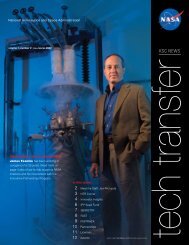2006-2007 - Kennedy Space Center Technology Transfer Office
2006-2007 - Kennedy Space Center Technology Transfer Office
2006-2007 - Kennedy Space Center Technology Transfer Office
- No tags were found...
You also want an ePaper? Increase the reach of your titles
YUMPU automatically turns print PDFs into web optimized ePapers that Google loves.
tracking objects after launch, and observing objects in space. Because these applicationsrequire imaging through the atmosphere at great distances, the images collected are oftenblurred and detail is often lost. Employing the device developed by EM Photonics to enhanceimages, NASA officials will have access to additional information to aid in key decisions.During launch, the added level of detail will provide the ability to make more informed “go”or “no go” decisions. For tracking rockets or the Shuttle, enhanced imagery will providemore detail on pieces that may fall from the craft during flight. Accounting for atmosphericeffects will also improve the quality of all images taken of space-based objects from Earth. Allapplications at NASA that require long-range imagery can be improved by rapidly enhancingthe collected data.Range SurveillanceRadio interferometry (RI) and time-difference-of-arrival (TDOA) techniques developed bySoneticom of Melbourne, Florida, are applied to survey, identify, and locate radio frequency(RF) energy signatures within a launch range or other strategic area. When deployed with aTDOA system, the range surveillance technology will allow an operator to identify and locatethe source of RF emissions more quickly and easily than can be accomplished today. Thistechnology greatly improves range safety by quickly locating the presence of an unauthorizedemitter or individual in a strategic area and by quickly providing graphic detail of potentialRF threats that could interfere with operations and launch activities.This technology was developed to assist the security team at KSC in finding intentional andunintentional intruders. The defined use for the technology is to increase security capabilitiesat the <strong>Center</strong> by identifying possible intrusion of inappropriate RF signals. The technologycan also be used for identifying sources of RF interferences during launch activities andtransport of payloads, as well as for asset and vehicle tracking. The technology works bytaking RF spectrum “images” of an area, by means of the TDOA system, and then comparingthe images over time to identify nominal and anomalous RF activity.AWARDS<strong>Kennedy</strong> <strong>Space</strong> <strong>Center</strong> continues to provide incentives to innovators through <strong>Space</strong> ActAwards. NASA’s Inventions and Contributions Board is authorized to recommend thegranting of <strong>Space</strong> Act Awards. The objectives of the <strong>Space</strong> Act Award program are to provideofficial recognition of and to grant equitable monetary awards for those inventions andother scientific and technical contributions that have helped to achieve NASA’s aeronautical,commercial, and space goals; and to stimulate and encourage the creation and reporting ofsimilar contributions in the future.Monetary Summary of <strong>Space</strong> Act Awards for <strong>2006</strong> and <strong>2007</strong><strong>2006</strong> <strong>2007</strong>Board Action Awards $153,650 $69,350Patent Application Awards $7,500 $19,000Software Awards $33,500 $34,000Tech Brief Awards $16,800 $14,000Total $211,450 $136,350KSC Innovative Partnership Program133/134













